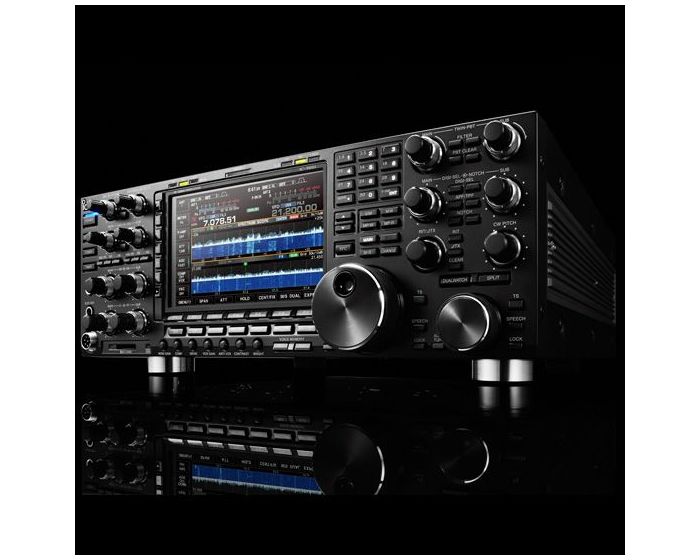
When you want to do something requiring additional flexibility, the other options will likely be appreciated.

While dramatically different from theĢ Figure 1 The rear-panel view of the IC While there are many connectors for various functions, normal operation can be conducted with just the 120 V ac power cable, one or more antenna connections, and a ground connection. Jacks are provided for external speakers for each receive channel, the optional keypad, and 13.8 V dc at 1 A to supply accessory equipment. Separate sockets are provided for a straight key or external keyer and for paddles to be used with the internal keyer perfect setup for my ancient Brown Brothers combination straight key and paddles. Thankfully, separate RCA jacks are also provided to control a non-icom linear amplifier via a PTT (note voltage and current limits) and ALC interface.
#10 MHZ REFERENCE FREQUENCY FOR IC 7800 PC#
The accessory sockets support operation of linear amplifiers or other equipment, including audio and control connections for use with a PC operating digital mode software. Each pair has one 7-pin and one 8-pin to avoid confusion. Four accessory sockets are provided, one pair dedicated to each receiver. An RJ-45 Ethernet jack is provided for remote operation via a LAN. There is even a pair of jacks for the Sony/ Philips Digital Interconnect Format (S/P DIF), a digital input/output format that can interface to some sound cards via fiberoptic cables. The USB Type-B supports a computer interconnection, but a connector for a classic Icom CI-V remote computer interface is available as well. The USB Type-A can be used for a computer keyboard, USB hub, or flash drive that can store the radio s configuration (an SD card slot is also available on the front panel). Many other connections are provided, including both USB Type-A and Type-B type connectors. While neither compact nor inexpensive, discriminating amateurs will likely be happy to find a place for it in their shack. Its quality is evident throughout its design, construction, and performance. Bottom Line The IC-7851 is an appropriate radio to sit at the top of the Icom transceiver lineup. A row of six BNC connectors is provided, one for a 10 MHz external frequency reference (can also be used to supply the radio s internal reference to other equipment), one for transverter interfacing, and two pairs for a receive-only antenna connection for either receiver that can also be used to insert an additional preamp or filter in either receiver input line. Antenna selection is also remembered on a band-byband basis. Connections are provided for up to four antennas via rear panel UHF sockets that can be selected from the front panel. Other features include a real-time dual spectrum scope (panadapter and/or waterfall display), a built-in antenna tuner, voice and CW memories, and digital-mode terminal functionality for RTTY and PSK with additional memories. Unlike the IC-7800, the IC-7851 does not swap receivers when operating split in the DUAL WATCH mode. The 7851 has two completely independent receivers that can operate on different bands, with different antennas if desired, and provide output to stereo headphones or two speakers.

In other Icom radios, pressing DUAL WATCH allows reception on two frequencies that are in the same band and signals on the two frequencies are combined in a single audio stream. While the second receiver is activated by the DUAL WATCH button, the IC-7851 works differently from other Icom transceivers. In addition, there is a built-in second receiver that matches the functionality and performance of its excellent primary receiver. This is a 200 W transceiver, and it includes the special 50 V dc internal power supply required by its final transistors. What it Does The IC-7851 is a large transceiver that includes a lot of features in a correspondingly large and heavy box. 2 The IC-7851 is Icom s latest response to the gradual improvement in dynamic response that has happened in the industry, as well as providing other improvements to what was their top of the line when we first saw the 7800 at the 2003 Dayton Hamvention. 1 In between, there were some other changes made to the 7800, as reported in a second review. Hallas, W1ZR QST Contributing Editor It seems like only yesterday that we first reviewed the then-new, top-of-the-line Icom IC-7800 transceiver, but it actually has been more than 10 years, and a lot has happened to amateur transceiver performance since then.

Wilson, Spencer, K1RO, WA8SME Icom IC-7851 HF and 6 Meter Transceiver Icom s flagship transceiver gets a makeover and a significant performance boost. 1 Product TechnicalReview Mark by Mark J.


 0 kommentar(er)
0 kommentar(er)
